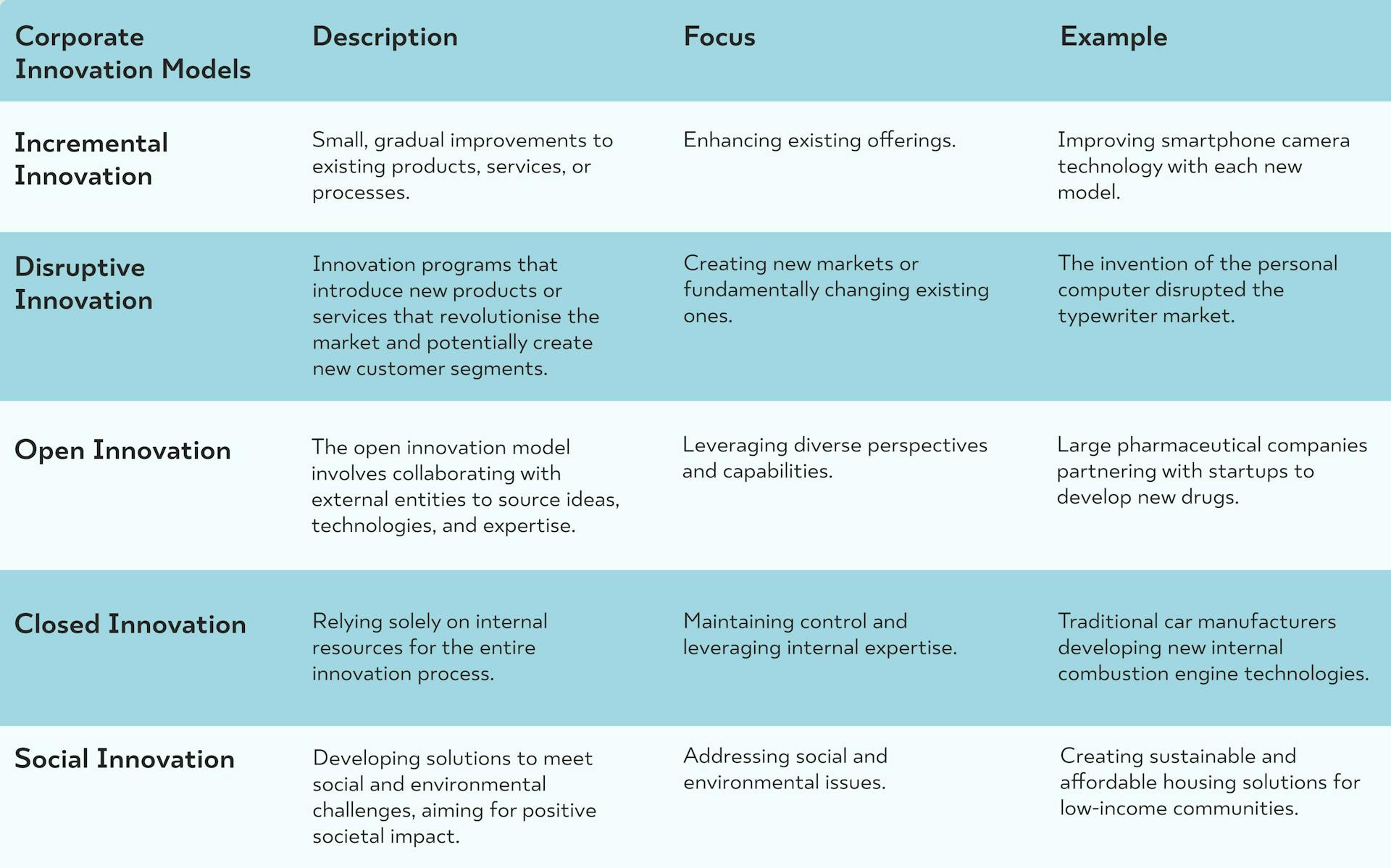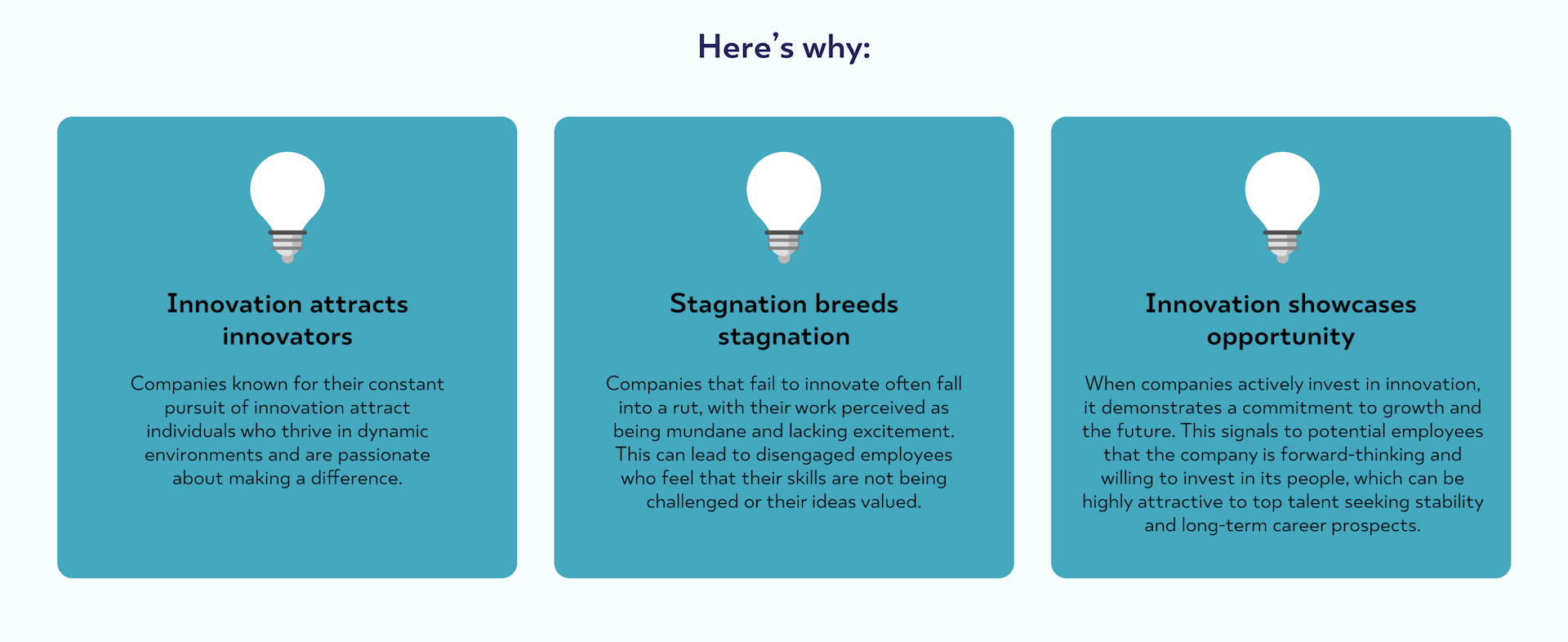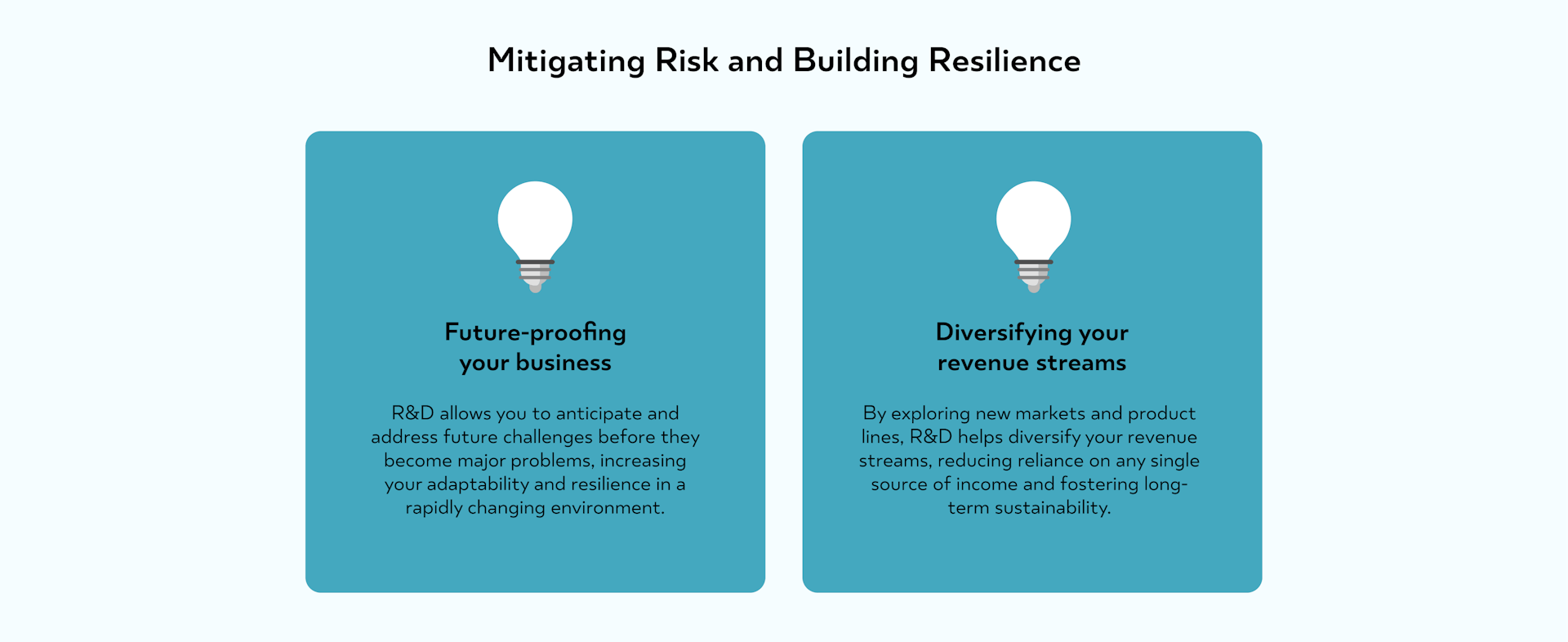Future-Proofing Your Enterprise: The Executive's Guide To Corporate Innovation

C-suite executives, we all know the drill: "innovation" is the buzzword du jour.
But beyond the boardroom jargon, it's the lifeblood of any organisation, driving progress and ensuring survival in a rapidly evolving business landscape.
87% of executives are on the same page, believing innovation is crucial for staying ahead and remaining competitive.
However, while the necessity of innovation is undeniable, large corporations often face unique hurdles. Some of these include:
➡️ Shifting entrenched habits
➡️ Fostering a culture of experimentation
➡️ And keeping pace with ever-evolving customer demands
Unlike nimble startups, turning a massive ship around requires careful navigation.
This article delves into why a corporate innovation strategy is crucial for big corporations and equips you with strategies to overcome any obstacles along the way.
We'll explore practical strategies and actionable tips to help you unlock the power of innovation and propel your company towards growth and success.
What Is Corporate Innovation?
At its core, corporate innovation refers to making changes that allow well-established corporations to stay ahead, be more efficient, or do things better.
This can include:
✅ Introducing new products and services
✅ New business models
✅ Improving existing services
✅ Enhanced internal processes
…The list goes on. Innovation isn't just about technology – it's about finding new solutions to old and new problems.
Corporate innovation efforts can take several different forms:

The Imperative for Innovation
Today, innovation isn't just a nice-to-have; it's a necessity for survival and growth. Here are 10 reasons why large organisations should prioritise constant innovation:
1. Stay ahead of the curve: The globalised market breeds fierce competition, with 52% of Fortune 500 companies from 2000 having gone bankrupt, been acquired, or ceased to exist by 2023. New players can emerge with disruptive solutions, so established companies must continuously innovate to differentiate themselves and maintain their edge.
2. Adapt to evolving customer needs: Customer expectations constantly shift, driven by technology and changing values. A study by Nielson showed that 63% of consumers say they like it when manufacturers offer new products. Companies must innovate to keep up, offering personalised, convenient, and sustainable products and services that foster loyalty.
3. Embrace technological transformation: Technology rapidly changes industries – from AI to blockchain. Companies must explore and adopt new technologies to enhance operations, create innovative products, and improve customer experiences.
4. Unlock new growth opportunities: Innovation opens new revenue streams and markets. Whether developing new products, exploring novel business models, or entering untapped markets, innovation is the key to finding and exploiting exciting opportunities.
5. Attract and retain top talent: The most talented individuals crave exciting challenges and the freedom to innovate. Research has shown that highly engaged employees are 87% less likely to start looking for a new job. This means that companies that foster creativity, experimentation, and learning will attract and retain top performers.
6. Ensure sustainability and social responsibility: As environmental and social issues have become increasingly important, companies must innovate towards sustainable practices, reducing waste, conserving resources, and developing solutions that benefit both society and their bottom line. Take Patagonia, for example. This outdoor apparel company use recycled materials in their products, is committed to minimising its environmental footprint, and actively advocates for environmental protection initiatives.
7. Navigate regulatory changes: Regulatory landscapes constantly evolve, especially in corporate environments like healthcare or finance. Innovation can help companies comply with new regulations efficiently and even turn them into competitive advantages.
8. Optimise operations: Innovation goes beyond products. It's about finding better ways to operate, such as streamlining processes, improving supply chains, and adopting new technologies. This can lead to significant cost savings and efficiency gains. Imagine an inventory management system that instantly tells you whether a shoe size is in stock, saving customers and staff time.
9. Build resilience for the future: Continuous innovation builds resilience, enabling companies to adapt and thrive in the face of disruptions, from economic downturns to technological shifts. This idea was emphasised in a 2023 BCG study, where 33% of companies planned to increase R&D spending despite an economic downturn. By embracing innovation, companies transform challenges into opportunities, ensuring long-term sustainability.
10. Cultivate a culture of continuous improvement: Innovation is a continuous journey, not a destination. Embedding a culture of innovation ensures that companies always look for ways to improve, evolve, and move forward. At Rocketmakers, we prioritise continuous improvement. Our commitment to innovation has recently been acknowledged through several awards at the UK Dev Awards.

When Is It Time to Innovate?
It's not always easy to tell when it's time to shake things up, but here are several key indicators that change is needed in your organisation.
Declining Market Share
A shrinking market share is a glaring warning sign for any business. It indicates that competitors are potentially offering better products, services, or experiences that resonate more with customers.
Traditional banks facing the rise of fintech startups exemplify this point.
These startups, offering innovative financial solutions like mobile payment apps and investment platforms, have become incredibly popular, with nearly half of consumers (48%) now using fintech apps.
Their seamless user experience has posed a significant challenge to traditional banks.
To compete, for example, Barclays embraced open banking. This strategic move allows third-party developers to build innovative financial apps that interact directly with Barclays' infrastructure.
This unlocked a wave of personalised and convenient services, including cardless payments and advanced financial planning tools.
By embracing open banking, Barclays countered potential market share decline and positioned itself as a leader in the digital banking revolution.
The Cost Crunch
Rising operational costs without increased productivity or efficiency scream "inefficiency".
Several factors can contribute to a cost crunch, including:
- Inefficient business processes
- Lack of automation
- Supply chain disruptions
- Failure to adapt to changing regulations (more on this below)
Take Kodak, for instance. Despite being a pioneer in film photography, Kodak's reluctance to embrace digital technology led to rising production costs for film while demand for digital alternatives surged.
This failure to adapt resulted in decreased revenue and the company's decline.
The Customer Feedback Loop
Listen closely to your customers. Consistent dissatisfaction or changing preferences are clear signs to rethink your offerings.
Netflix's pivot from DVDs to streaming exemplifies the power of the customer feedback loop.
By listening closely to customer preferences for online content consumption, they identified a market shift and adapted proactively.
This shift from physical media to online streaming perfectly aligned with the evolving needs of their audience, leading to explosive growth.
Today, Netflix stands as one of the biggest streaming platforms globally, with over 260 million paid subscribers worldwide (as of Q3 2023).
This remarkable success story is a testament to their commitment to customer-centricity and ability to adapt to changing market dynamics.
Disruptive Technology
New technologies disrupting your industry are a sign that things are changing and that your organisation needs to respond to that.
The hotel industry, for example, was transformed by Airbnb, which catered to a growing demand for authentic and immersive experiences.
Airbnb expanded the travel landscape by providing a wider range of accommodation options beyond traditional hotels. These options were often more budget-friendly, making travel accessible to a broader audience.
Additionally, they simplified the booking process with a user-friendly online platform.
This disruption had a ripple effect, impacting not only individual hotels but the entire hospitality industry, forcing it to re-evaluate customer experience and innovate service offerings.
Case Study: Marriott International Adapts to Disruption
Facing the challenge of Airbnb's disruptive model, Marriott International took strategic steps to remain competitive. Recognising the growing desire for unique experiences, they launched "Marriott Bonvoy Moments", offering travellers local tours, cooking classes, and other immersive activities.
Additionally, they created "Marriott Homes & Villas", a platform mirroring Airbnb's vacation rentals, providing guests with flexibility and variety while retaining Marriott's brand association and loyalty benefits.
These strategic responses demonstrate Marriott's commitment to innovation and adaptation in a rapidly changing market.
The Talent Drain
The inability to attract and retain top talent can be a red flag indicating a lack of innovation in your company.
Top talent is often drawn to organisations that embrace new ideas and consistently push the boundaries.

Tesla: A Case Study in Attracting Talent through Innovation
Tesla's approach to innovation extends beyond its products, influencing its development process as well. With a focus on quick iteration cycles and continuous improvement, Tesla fosters a dynamic work environment. This appeals to top engineers and designers looking for a place where their work can make a significant impact.
For example, a Tesla Model X reportedly receives 27 software updates a day. This rapid iteration cycle ensures constant challenges and keeps the team motivated.
Shifting Regulations
New regulations often serve as a powerful driving force for innovation.
In the automotive industry, stricter global emissions regulations are pushing established players to accelerate their transition towards electric vehicles (EVs).
Volkswagen, aiming to become a leader in the EV race, launched its "Accelerate" strategy in 2021 in the wake of the "dieselgate” scandal.
This ambitious plan involves heavy investments in developing new EV platforms, expanding their charging infrastructure, and forging strategic partnerships with battery companies.
Their commitment to electrification is evident in their targets – hitting 80% EV sales in Europe and 55% in North America by 2030.
This example exemplifies how regulations can enforce compliance and serve as a springboard for innovation, shaping the future of the automotive industry.
Global Market Shifts
Global shifts like emerging markets or geopolitical changes require adaptation. Consumer goods companies are constantly innovating products by tailoring them to emerging markets, focusing on affordability and local preferences.
For example, to address water scarcity concerns in certain regions and cater to limited access to washing machines, Unilever has developed washing powders that require less water.
Remember, innovation isn't just about fixing problems; it's about constantly seeking improvement, growing, and staying ahead of the curve.

How to Start Innovating
In today's dynamic business landscape, staying competitive and relevant requires constant innovation.
This section delves into eight key strategies to cultivate a sustainable innovation culture that delivers long-term success.
Foster a Culture of Innovation
What separates highly agile startups from larger organisations is their ability to look for alternative ways of doing things.
They ask, “Is there a better way to do this?”, and this is what an innovation culture is. Organisations often get stuck in the ‘old’ way of doing things because it’s the safest bet.
There isn’t a foolproof method to cultivate innovation in an organisation, but here are some strategies to get you started:
Empower Your People
As a leader, you must create an environment where everyone feels comfortable contributing ideas.
To jumpstart this process, identify a specific problem or challenge your team faces, like increasing customer retention or streamlining a complicated internal process.
Instead of dictating solutions, challenge every member of your team to develop diverse approaches.
You'll be surprised by the wealth of creative solutions they generate when empowered to think outside the box.

In addition to providing team members with the autonomy and resources they need to explore ideas, delegate decision-making authority to lower levels whenever possible. This streamlines processes, avoids bottlenecks, and fosters a sense of responsibility and ownership among team members.
Don’t Be Afraid to Fail
Soichiro Honda said that “success is 99% failure". Yet, fear of failure often hinders innovation.
Remember, each "failure" is a valuable lesson. Innovation thrives in environments that embrace risk-taking.
Consider your team's response to unsuccessful ideas. Harsh reactions can stifle future creativity, leading to missed opportunities.
Encourage new ideas, provide constructive feedback on internal innovation projects, and empower your team to experiment. Turn mistakes into learning experiences, not punishments.
Promote Cross-Functional Collaboration
Breaking down silos by fostering collaboration between different departments is crucial for innovation. Consider the invention of Post-it Notes.
In the 1960s, Spencer Silver, a 3M scientist, accidentally developed a low-tack adhesive that wouldn't stick permanently. Initially, the discovery seemed useless.
Instead of abandoning the project, 3M encouraged collaboration between different departments.
Art Fry, a researcher from another department, noticed the adhesive's unique properties and envisioned using it for bookmarks that wouldn't damage pages.
This unexpected connection sparked the creation of an iconic product still widely used today.
Keep Pace with Technological Change
Establishing a dedicated team or appointing individuals to monitor and evaluate emerging technologies ensures the company remains on the cutting edge.
Here’s how to do this:
External Partnerships
Breaking down silos doesn't stop at your company doors. Corporations can boost innovation by bringing on a technology partner to help bring their new product ideas to life
Technology partners can offer specialised expertise in areas such as software development, UX/UI design, and emerging technologies. This allows corporations to tap into skills and resources they may not have in-house.
These partnerships can accelerate development, reduce risk, and help ensure products are built with cutting-edge technologies and user-centric design principles.
The key is to find a partner with a proven track record in your industry and a deep understanding of your target market.
Pfizer and BioNTech's COVID-19 vaccine collaboration exemplifies the power of external partnerships.
By combining Pfizer's resources and global reach with BioNTech's mRNA technology, they could develop and distribute a vaccine at an unprecedented pace.
🚀 Is the innovation gap leaving your organisation behind? Bridge it today with Rocketmakers.
Large organisations face the challenge of staying agile and innovative amidst rapid changes.
We’ve had great success helping companies overcome this hurdle and recently won the Innovation award at the 2024 UK Dev Awards for our work on machine learning and AI analysis in a commercial environment.
Our culture of innovation also means that we are continuously looking to push the boundaries with our own applications, including AI applications like Portrait and YourRoom.
We’d like to help you create innovative solutions tailored to your needs. As a technology partner, we have the expertise to help you stay ahead of the curve.
Make your next move your best move. Reach out to Rocketmakers today.
Use Open Innovation Platforms
Open innovation platforms invite people from all over to share their ideas with your company.
This can be a great way to solve problems or find new directions that you hadn't thought of before. It's like asking the world for its best ideas and seeing what comes back.
For example, LEGO Ideas is an open innovation platform where the community submits and votes on new product ideas.
Successful ideas are turned into commercial products, with the creator receiving recognition and a share of the profits.
Invest in R&D
Investing in R&D isn't just an expense, it's a strategic investment in your company's future.
Many organisations agree with this sentiment. In 2019, organisations around the world spent $2.3 trillion on R&D. That’s roughly 2% of global GDP.
If you haven’t incorporated a corporate innovation lab into your organisation – now is the time. Here's how a dedicated R&D department can drive innovation:
Fueling Growth
Dedicated innovation teams explore emerging technologies, market trends, and consumer needs, leading to the creation of groundbreaking new products and services that propel long-term growth.
It doesn’t stop at creation; a dedicated innovation team seeks continuous improvement.
By constantly asking, "how can this be better?" R&D ensures your existing offerings remain competitive and relevant in the market.
Staying Ahead of the Curve
R&D teams keep you at the forefront of technological advancements, allowing you to identify and capitalise on emerging market opportunities before competitors.
Successful corporate innovation programs translate to increased market share and a stronger competitive edge.

Google, now under Alphabet, invested $45.4 billion into R&D in 2023 across various fields, from quantum computing to health technology.
Their commitment to R&D keeps them at the forefront of technological innovation and continuously opens new revenue streams.
Encourage Intrapreneurship
Your people are your best asset, so use them to their full potential. Another great way to incorporate innovation into your organisation is to develop an intrapreneur program.
These corporate innovation programs provide employees with innovative ideas the resources, time, and support they need, allowing them to develop them within the company.
For example, LinkedIn launched a program that allows employees to pitch their ideas to the executive team. Successful pitches receive resources, support, and time away from their regular jobs to develop their projects.
Make Strategic Acquisitions
Strategic acquisitions involve buying startups or businesses that bring new technologies or skills to the table.
This approach can quickly boost innovation by introducing fresh perspectives and expertise.
It allows companies to expand their capabilities, access new markets, and accelerate the development of new products or services.
Embrace Sustainability and Social Responsibility
In 2024, innovation extends beyond the bottom line. It's about creating positive change. Here are two key strategies to consider:
Integrate Sustainability into Your Innovation Strategy
Explore ways to reduce your environmental impact and contribute positively to society.
This could involve developing eco-friendly products, implementing renewable energy solutions, or minimising waste throughout your operations.
Foster Meaningful Partnerships
Don't innovate in a vacuum. Collaborate with organisations and individuals who share your commitment to sustainability and social responsibility.
Utilise their diverse perspectives and knowledge to identify shared needs and develop solutions that resonate with a broader audience.
By embracing these strategies, you can transform your innovation process from solely profit-driven to one that creates positive change for the planet and society.
This can lead to meaningful, sustainable solutions that resonate with your stakeholders and position your company as a leader in responsible innovation.
Attract and Retain the Right Talent
Attracting and retaining top talent isn't just a way to fill positions; it's the key to unlocking your company's full innovation potential.
The right people bring new ideas, drive, expertise, and collaborative energy that propel your organisation towards consistent success through innovation.
Here’s how to hire and retain the right talent:
Prioritise Diversity and Inclusion
Research has shown that ethnically and culturally diverse organisations are 36% more profitable.
The bottom line is that you should seek employees with diverse skills, backgrounds, and perspectives. This approach fosters a wider range of ideas and helps identify potential blind spots in your solutions.
To retain these hires, you must create an inclusive environment where everyone feels valued, respected, and comfortable sharing their ideas.
This encourages participation, reduces fear of failure, and unlocks the team's collective creativity.
Celebrate Innovation and Reward Success
Recognise and celebrate both individual and team achievements in innovation. This motivates team members, reinforces the value of innovation, and keeps them engaged in the process.
Also, offer rewards that go beyond just financial incentives. Consider recognition programs, opportunities for professional development, or the chance to work on even more challenging and impactful projects.
Promote Continuous Learning
Encourage continuous learning and skill development within the team. This ensures everyone has the knowledge and expertise to tackle complex challenges and adapt to evolving trends.

Communicate the vision and benefits of innovation clearly and regularly. Involve employees at all levels in the innovation process, and provide training and resources to help them adapt to new ways of working.
Leverage Data for Decision-Making
Data empowers businesses to move beyond intuition and make informed decisions based on objective insights. Analysing data helps:
➡️ Identify emerging trends and unmet customer needs.
➡️ Enable better decision-making, reducing the chances of costly failures.
➡️ Streamline workflows, improve efficiency, and maximise resource allocation.
➡️ Reveal customer needs and preferences, enabling businesses to tailor products and services for higher satisfaction and loyalty.
Take Netflix, for example. Their data-driven approach analyses viewer preferences, watch times, and search habits.
This personalises recommendations and guides content creation, leading to the development of highly successful original series and films that resonate with their audience.
Key Takeaways
The path to long-term success in today's dynamic business landscape requires embracing a culture of continuous innovation.
By strategically leveraging incremental, disruptive, open, and social innovation approaches, companies can unlock new potential, build resilient ecosystems, and stay ahead of the curve.
Implementing successful innovation programs requires overcoming internal resistance, fostering collaboration, and investing in R&D and sustainable practices.
Recognising the signs necessitating innovation, like market share decline or talent drain, is crucial for initiating transformative change.
Partner with Rocketmakers
Rocketmakers understands the complexities of navigating the innovation landscape.
We bridge the gap between startup agility and enterprise expertise, delivering custom software solutions that fuel your organisation's specific needs and innovation goals.
Don't wait to future-proof your business. Contact us today, and let's transform your innovation strategy together, turning challenges into opportunities for sustainable growth and success.



